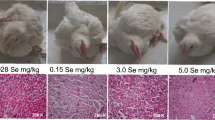Abstract
A new selenium source, Nano red elemental selenium (Nano-Se) was used to study the effect on the GPx activity of broiler chick kidney cells (BCKC)in vitro, Sodium selenite (Na2SeO3) and seleno-1-methionine (Se-Met) were used as the controls. The results showed that the effects of three kinds of Se forms on the GPx activity of BCKC were accordant (p>0.05) compared with each other at 0.01. 0.05 and 0.10 μmol/L Se concentrations treatments. In the range of 0.00–0.10 μmol/L Se concentrations, the GPx activity increased with elevation of Se concentrations in medium. For the three kinds of Se forms, the GPx activity reached the climax at 0.10 μmol/L Se concentration. At 0.20 and 0.30 μmol/L Se concentrations, the influnces of three kinds of Se forms were not accordant with one another. For Nano-Se, the GPx activity at 0.20 and 0.30 μmoi/L Se concentrations remained the same as that at 0.10 μmol/L Se concentration treatment. For Se-Met, the GPx activity at 0.20 μmol/L Se concentration treatment remained the same with 0.10 μmol/L treatment; the GPx activity at 0.30 μmol/L Se concentration treatment was declined significantly (p<0.05) compared with 0.10 or 0.20 μmol/L treatment. For Na2SeO3, the GPx activity falled gradually with Se concentration increasing from 0.10 μmol/L to 0.30 μmol/L, and at 0.30 μmol/L Se concentration treatment, the GPx activity was less than the original of BCKC. The results implicated, on the GPx activity of BCKCin vitro, the ranking of width range of the most suitable Se concentration for nutrition curve of the three Se formes is Nano-Se>Se-Met>Na2SeO3.
Similar content being viewed by others
References
Burk R F, Hill K E. Orphan Selenoproteins.Bioessays, 1999,21(3):231–237.
Bao Yong-ping, Williamson G. Selenium-dependent Glutathione Peroxidases.Progress in Natural Science, 2000,10: 321–330.
Ursini F, Maiorino M, Gregolin C. The Selenoenzyme Phospholipid Hydroperoxide Glutathione Peroxidase.Biochem Biophys Acta, 1985,839: 62–70.
Kayanoki Y, Fujii J, Islam K N. The Protective Role of Glu-tathione Peroxidase in Apoptosis Induced by Reactive Oxygen Species. J Biochem, 1996,119: 817–822.
Margaret P R. The Importance of Selenium to Human Health (Review).The Lancet, 2000,356(9225): 233–241.
Doni M G. The Effect of Vitamin E or Selenium on the Oxidant-antioxidant Balance in Rats.Br Exp Pathol, 1984,65: 75.
James E O. The Two Face of Selenium.J Nutr, 1987,117: 2002.
Levander O A. A Global View of Human Selenium Nutrition.Ann Rev Nutr, 1987,7: 227–250.
Yang Guang-qi. Research on Selenium-related Problems in Human Health in China. Selenium in Biology and Medicine.Third International Symposium. 1987, AVI: 9-32.
Brigelius-Flohe R, Lotzer K, Maurer S. et al. Utilization of Selenium from Defferent Chemical Entities for Selenoproten Biosymthesis by Mammalian Cell Lines.BioFactors, 1996,5: 125.
Mente D G, Sabichi A L. Lippman S M. Selenium Effects on Prostate Cell Growth.Cancer Epidemiology. Biomarkers & Prevention, 2000,9: 1171–1182.
Combs G F, Garbisu C, Yee B C, et al. Bioavailability of Selenium Accumlulated by Selenite-reducing Bacteria.Biol. Trace Elem Res, 1996,52: 209–225.
Ganther H E. Pathways of Selenium Metabolism Including Resiratory Excretory Products.J Am Coll Toxicol, 1986,5: 1–5.
Zhang Jin-song, Gao Xue-yun, Zhang Li-de, et al. Biological Effects of A Nano Red Elemental Selenium.BioFactors, 2001,15: 27–38.
Bradford M M. A Rapid and Sensitive Method for the Quantification of Microgram Quantities of Protein Utilizing the Principle of Protein-dye Binding.Anal Biochem, 1976,7: 248–254.
Wendel A. Glutathione Peroxidase.Meth Enzymol, 1981,77: 325–333.
Snedecor G W, Cochran W G. tStatistical Methods, 6th Ed, Ames: Iowa State Univ Press, 1976. 298.
Wang Oiang, Xu Hui-bi. The Toxicity of Trace Element Selenium.Chemistry of Life, 1994,14(2): 34–35 (Ch).
Freshney R I.Animal Cell Culture: A Practical Approach. Oxford: Oxford University Press, 1986. 13–30.
Jiang Long. Quantum Size Nanometer Particles and Its Application in Biological System.J Inorganic Chemistry, 2000,16(2): 185(Ch).
Gao Xue-yun, Zhang Jin-song, Zhang Li-de. Acute Toxicity and Bioavailability of Nano Red Elemental Selenium.J of Hygiene Research, 2000,29(1): 57–58 (Ch).
Author information
Authors and Affiliations
Corresponding authors
Additional information
Foundation item: Supported by the Key Item of the Science and Technology Bureau of Zhejiang Province (021122680)
Biography: Xu Bao-hua (1966-), male, Associate professor, Ph. D. research direction: nanobiology and animal nutrition.
Rights and permissions
About this article
Cite this article
Bao-hua, X., Zi-rong, X., Mei-sheng, X. et al. Effect of Nano red elemental selenium on GPx activity of broiler chick kidney cellsin vitro . Wuhan Univ. J. Nat. Sci. 8, 1161–1166 (2003). https://doi.org/10.1007/BF02903692
Received:
Issue Date:
DOI: https://doi.org/10.1007/BF02903692




